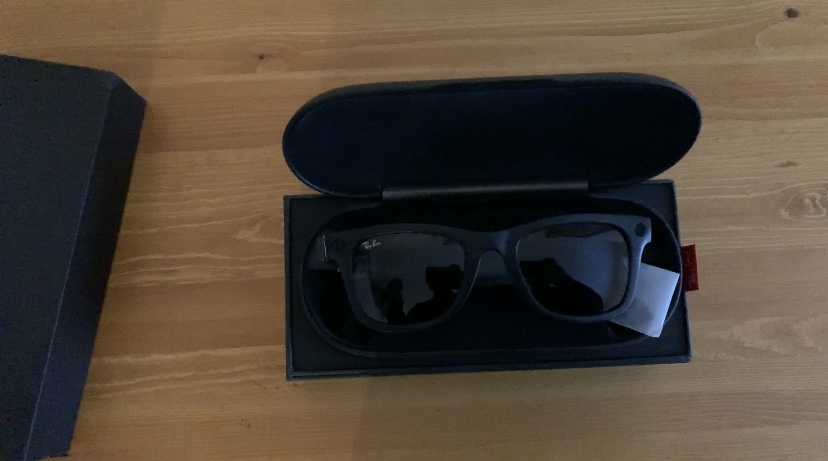 Ray-Ban Stories are a stylish and simple way to take pictures and capture video for your social media sharing needs. These smart glasses are easy to set up, easy to use, and even come with internal storage so that you don’t have to keep your phone on you at all times. While there are a few different types of rims and lenses in the Stories line, my review focuses specifically on Ray-Ban’s Wayfarer sunglasses. The functions are the same across all models, however.
Ray-Ban Stories are a stylish and simple way to take pictures and capture video for your social media sharing needs. These smart glasses are easy to set up, easy to use, and even come with internal storage so that you don’t have to keep your phone on you at all times. While there are a few different types of rims and lenses in the Stories line, my review focuses specifically on Ray-Ban’s Wayfarer sunglasses. The functions are the same across all models, however.
Unboxing your Ray-Ban Stories smart glasses
 The unbox of these glasses is pretty simple. The glasses themselves come in a hard shell carrying case. Packed below that, you have a lengthy USB-C cable, warranty card info, and a carrying sleeve if you wish to travel lighter than the bulkier case. The hard shell carrying case also acts as your charge dock for the glasses. The case charges through USB-C and is then capable of charging the glasses fully, up to 3 times.
The unbox of these glasses is pretty simple. The glasses themselves come in a hard shell carrying case. Packed below that, you have a lengthy USB-C cable, warranty card info, and a carrying sleeve if you wish to travel lighter than the bulkier case. The hard shell carrying case also acts as your charge dock for the glasses. The case charges through USB-C and is then capable of charging the glasses fully, up to 3 times.
Specs for these specs
Pardon the bad pun. The Ray-Ban Stories smart sunglasses feature two cameras (on either side of lenses) built in for convenient use. The camera does have some internal memory, which is enough to capture a couple of hundred snaps, or about 15 minutes of video footage. Pictures are snapped using the onboard 5 MP camera at 2592 x 1984 resolution. Videos are 30 FPS at a square 1184 x 1184. There are a couple of microphones positioned at different points for sound capturing, and your glasses can also take phone calls and stream audio for you while you wear them.
You’re looking at about 6 hours worth of use with a full charge, or 3 while you stream audio nonstop. While the glasses will tell you how much battery life is left when you put them on, you can always check how much is left when you open the app too.
If you require a prescription, you can still use these glasses. While you can’t do this direct through Best Buy, it looks as though Lens Crafters has various Stories online for Canadians where you could have your glasses fitted with prescription lenses.
A note on design
As somebody who has worn prescription glasses all their life, there’s no weight difference at all between these and my normal specs. The added electronics on the right side of the frame does make it a bit (obviously) bulkier than a normal pair of glasses, but you won’t notice or feel a difference. The design is really well done and a friend of mine who owns a pair of regular Wayfarers was impressed at how they managed to fit all the tech without compromising any of the design. They don’t look out of place and unless you are recording or taking pictures (more on that below,) they just look like a regular pair of sunglasses from afar. The design is really well done.
Setting up your Stories smart glasses
 Setting your glasses up is an extremely easy process and is self guided through the Facebook/Meta App. Before starting, I’d recommend charging the carrying case, which also doubles as a charge dock for your glasses. There’s a small LED on the front side of the case which will change colour from amber to green once charged. You may also want to pull away the tab on the glasses to charge it simultaneously, but if you forget, you will be reminded during the setup process.
Setting your glasses up is an extremely easy process and is self guided through the Facebook/Meta App. Before starting, I’d recommend charging the carrying case, which also doubles as a charge dock for your glasses. There’s a small LED on the front side of the case which will change colour from amber to green once charged. You may also want to pull away the tab on the glasses to charge it simultaneously, but if you forget, you will be reminded during the setup process.
The camera connects to your smartphone using either localized Wi-Fi or Bluetooth. When you download the Facebook/Meta View App, it will guide you through the entire installation process, which can take anywhere from 15-45 minutes, depending on whether you charged the glasses while charging your case. If not, it recommends that you take about 30 minutes to charge your glasses in-case. You’ll also need to run a firmware update.
The setup is so quick and so painless that once you have confirmation that it’s set up, that’s it. You can put the glasses on and begin using them right away.
Using Ray-Ban Stories smart glasses
Getting these glasses up and going could not be any easier. Just take them out of the case, flip the power switch and put them on. You’ll receive a small notification of battery life remaining and then you’re ready to go.

In order to take pictures, you just hold down the button at the top of the right side temple and you’ll hear a shutter sound which will tell you that the picture was taken. If you want to take a video, just tap it to start and to finish (or, if you reach the end of your designated recording time, your glasses will just stop recording.) The glasses have a virtual voice assistant enabled too, so you can give appropriate voice prompts as well.
You can choose between 30 and 60 second video lengths through the app, and can upload everything to your smartphone direct from the app fairly quickly. The app will tell you how many items your glasses are storing for upload. The demo slides always remain available to you through the app if you ever forget how to operate your glasses.
Once uploaded, you can use the Facebook View App to edit and post direct to socials or save to your camera roll. The first time you save to your roll, you can also turn on auto-imports
I will admit that I did not use the Bluetooth speakers much outside of my initial testing. The audio quality is just fine and it’s a nice feature to have, but I like listening to music pretty loud, and since the speakers can project outward, I didn’t want to be “that guy” and project my music and phone calls for all to hear. I’ll stick to my earbuds for those.

How does the picture and video quality stack up?
I was a little concerned when I saw the specs for the camera that quality might be an issue. That said, I was pleasantly surprised at how it captured things while in motion. The shot above is of me standing still to take a picture at some bus stop graffiti while I went to get some coffee vs. when I walked past it again a few minutes later. Aside from the angle, quality loss is minimal (in my opinion anyway.)
I also took videos at varying speeds—while walking, while jogging, and even while I was driving. They all came out pretty well. I show a couple of captures in motion in the video review.
One thing that I did kind of miss out on where I will say smartphone technology wins out is that I couldn’t seem to take a picture while taking a video. I’ve been able to take simultaneous video and screen caps with my smartphones for years, and I assumed that this functionality was built in. However, that didn’t seem to be the case, as the video would stop every time I tried to take a picture while walking. This is a mild inconvenience, as I came across a couple of things in travels where it would have been nice to have still shots.
If you are curious, however, about how the camera performs up against a smartphone in lower lighting situations (I think it does pretty well in regular daylight,) here’s a side by side of an early evening photo taken by Stories and by a smartphone.

Privacy concerns
While I was wearing these glasses around friends and talking about reviewing them, every single one of them brought up privacy concerns and being secretly recorded, which is a fair point. With your smartphone out, it’s a lot more obvious that you’re doing something with it than it is with sunglasses. Privacy has been a big consumer question around smart glasses, and these are no exception. To help deal with some of those concerns, the Ray-Ban Stories are designed to make your intentions obvious. You cannot turn any of the notification sounds off and while you record, a small white LED light turns on at the right side front. My daughter stood to my left while I took a couple of pictures with the glasses while we were out walking, and she said she could hear the shutter sounds each time.

Who are these glasses best suited for?
I had a long think about who these glasses would be best suited for. Those with active lifestyles can definitely benefit from the quick and easy video functions. I thought about how fun it might be to take my friend’s dog to the park in the summer and take point-of- view videos of us playing with a frisbee. I’ll be taking these out on my hikes and walks in the summer and it means I won’t have to pull out my phone to take pictures or videos of trails. I might not utilize the music or phone call features much, but they are nice to have and I know some of you will like having that available in a one-stop shop.
There are also some really cool uses that I could see coming out of the sports world as well. Social media stories of practice/warm-ups at ice level or court level, for example. I will also be taking these to some pro wrestling events to see if we can get some footage from inside the ring looking out at attendees, or perhaps capturing clips from the referee’s point of view. This is definitely a great tool for influencers and full-time content creators. My daughter says she wants to start a Pokemon card opening channel, and hands free recording while she opens a pack up will make it so much easier for her!
That said, I do think that these are still pretty niche right now. They’re really cool, don’t get me wrong, but most people I know might be content using their phone cameras for similar purposes. A couple of people asked me about the idea of amateur filmmakers using this to film. While it is possible, it might be tough to work within the constraints of square video and 60 second clips if you’re doing longer movies or filming with different cameras at different ratios. That said, the ease of use is definitely huge, but the price point might be hard to swallow for people that don’t have a specific use for them, or that aren’t typically early adopters.
Final thoughts
I do think that the Ray-Ban Stories are fun and a good fit for the right audience. Chances are that I will be using this in future reviews too! That said, since the video lengths and resolution are optimized for Meta’s social media, it might feel a bit restrictive to people who are used to the freedom of choices from their smartphone, especially when it comes to resolution and framerates. If this type of tech doesn’t interest you right now, it doesn’t mean it won’t in future. From release, there have already been a few improvements, and I’m sure we have not seen the last of them yet.
Ray-Ban Stories smart glasses are now available at Best Buy and online at BestBuy.ca



